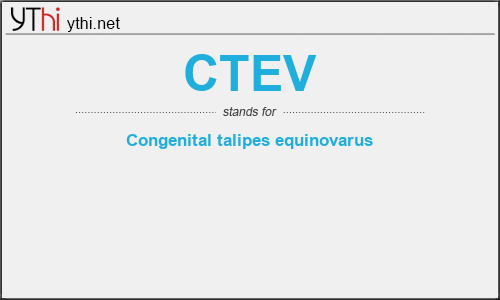What does CTEV mean? What is the full form of CTEV?
The Full Form of CTEV is Congenital talipes equinovarus.
Idiopathic (non-syndromic) congenital talipes equinovarus, or clubfoot, is a poorly understood but common developmental disorder of the lower limb, which affects at least 2 per 1000 Scottish births (ISD data). It is defined as a fixation of the foot in a hand-like orientation – in adduction, supination and varus – with concomitant soft tissue abnormalities. Despite advances in treatment, disability often persists. The aetiology of the condition has been little studied and is poorly understood. Neurological, muscular, bony, connective tissue and vascular mechanisms have been proposed, but the only firm evidence is that the mildest cases appear to be associated with intra-uterine posture. There is evidence for a genetic contribution to congenital talipes equinovarus aetiology. Its incidence varies with ethnic group, and we found that a family history is present in 24–50% of cases, depending on the population studied. Complex segregation analysis suggests that the most likely inheritance pattern is a single gene of major effect operating against a polygenic background. Possible mechanisms for congenital talipes equinovarus are discussed.
Congenital talipes equinovarus (CTEV), often known as ‘club-foot’, is a common but little studied developmental disorder of the lower limb. It is defined as fixation of the foot in adduction, in supination and in varus, i.e. inclined inwards, axially rotated outwards and pointing downwards (Fig. 1). The calcaneus, navicular and cuboid bones are medially rotated in relation to talus, and are held in adduction and inversion by ligaments and tendons. Although the foot is supinated, the front of the foot is pronated in relation to back of the foot, causing cavus. In addition, the first metatarsal is more plantar flexed. Congenital talipes equinovarus is termed ‘syndromic’ when it occurs in association with other features as part of a genetic syndrome, or it can occur in isolation in which case it may be termed ‘idiopathic’. Syndromic talipes equinovarus arises in many neurological and neuromuscular disorders, for example spina bifida or spinal muscular atrophy, but the idiopathic form is by far the most common. The upper limb is normal in idiopathic CTEV.
CTEV
means
Congenital talipes equinovarus![]()
Translate Congenital talipes equinovarus to other language.


Leave a Reply
You must be logged in to post a comment.